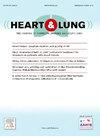Factors related to the decision to perform synchronized cardioversion for supraventricular tachyarrhythmias by prehospital emergency medical services workers
IF 2.4
4区 医学
Q2 CARDIAC & CARDIOVASCULAR SYSTEMS
引用次数: 0
Abstract
Background
While clinical indicators for synchronized cardioversion in regular supraventricular tachycardias are well-established, their application by prehospital emergency medical services (EMS) still needs to be explored.
Objective
The purpose of this study was to evaluate the factors influencing the decision-making process of prehospital EMS personnel to perform synchronized cardioversion in adults with narrow QRS regular tachyarrhythmias.
Methods
This descriptive study included 598 paramedics actively engaged in prehospital EMS. Data were collected using a form that included questions about their experiences with synchronized cardioversion and presented three cases involving narrow QRS regular tachyarrhythmias. Since the data did not exhibit a normal distribution, the Mann-Whitney U test was employed to evaluate the significance of differences between the variables "number of previous SC applications" and "not performing SC despite recognizing unstable findings".
Results
The participants comprised 320 males (53.5 %) and 278 females (46.5 %). A majority (93.8 %, n = 561) had attended postgraduate training on synchronized cardioversion (SC) for adult patients, and 220 participants (36.8 %) reported prior experience performing synchronized cardioversion, with an average of three applications each. Despite recognizing sufficient clinical findings of unstable status for synchronized cardioversion in narrow QRS regular tachyarrhythmias, 177 participants (29.6 %) reported instances where they chose not to perform the procedure. Immediate synchronized cardioversion was preferred by 319 participants (53.3 %) in cases of altered mental status; however, this rate decreased to 16.9 % (n = 101) for ischemic chest discomfort and 30.4 % (n = 182) for acute heart failure cases.
Conclusions
Previous experience with synchronized cardioversion and the proximity to the receiving hospital are key factors in the decision-making process. Additionally, the type of unstable finding is critical in making the decision for synchronized cardioversion.
院前急救医务人员决定对室上性心动过速进行同步复律的相关因素
背景:虽然常规室上性心动过速同步复律的临床指标已经确立,但其在院前急救服务(EMS)中的应用仍有待探索。目的:探讨影响院前急救人员对窄QRS型心律失常患者进行同步心律转复决策的因素。方法:对598名积极参与院前急救的医护人员进行描述性研究。数据收集使用了一种表格,其中包括关于他们同步心律转复的经历的问题,并提出了三个涉及窄QRS规则性心动过速的病例。由于数据不呈现正态分布,因此采用Mann-Whitney U检验来评估变量“以前SC申请的数量”和“尽管认识到不稳定的发现但不执行SC”之间差异的显著性。结果:男性320人(53.5%),女性278人(46.5%)。大多数(93.8%,n = 561)参加了成人患者同步心律转复(SC)的研究生培训,220名参与者(36.8%)报告了先前进行同步心律转复的经验,平均每人进行三次。尽管认识到有足够的临床证据表明窄QRS期常规速性心律失常患者同步心律转复状态不稳定,但177名参与者(29.6%)报告了他们选择不进行该手术的情况。在精神状态改变的情况下,319名参与者(53.3%)更倾向于立即同步心肺复律;然而,缺血性胸部不适患者的这一比例降至16.9% (n = 101),急性心力衰竭患者的这一比例降至30.4% (n = 182)。结论:既往同步心律转复经验及与接收医院的距离是决定是否进行同步心律转复的关键因素。此外,不稳定发现的类型是决定同步心律转复的关键。
本文章由计算机程序翻译,如有差异,请以英文原文为准。
求助全文
约1分钟内获得全文
求助全文
来源期刊

Heart & Lung
医学-呼吸系统
CiteScore
4.60
自引率
3.60%
发文量
184
审稿时长
35 days
期刊介绍:
Heart & Lung: The Journal of Cardiopulmonary and Acute Care, the official publication of The American Association of Heart Failure Nurses, presents original, peer-reviewed articles on techniques, advances, investigations, and observations related to the care of patients with acute and critical illness and patients with chronic cardiac or pulmonary disorders.
The Journal''s acute care articles focus on the care of hospitalized patients, including those in the critical and acute care settings. Because most patients who are hospitalized in acute and critical care settings have chronic conditions, we are also interested in the chronically critically ill, the care of patients with chronic cardiopulmonary disorders, their rehabilitation, and disease prevention. The Journal''s heart failure articles focus on all aspects of the care of patients with this condition. Manuscripts that are relevant to populations across the human lifespan are welcome.
 求助内容:
求助内容: 应助结果提醒方式:
应助结果提醒方式:


